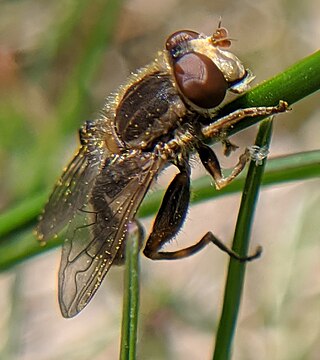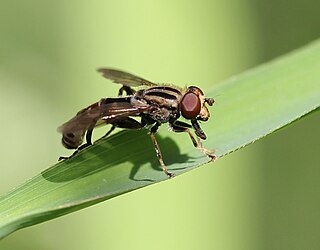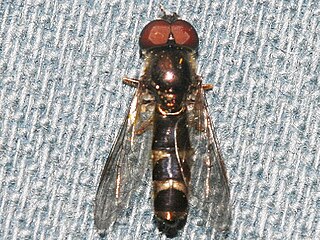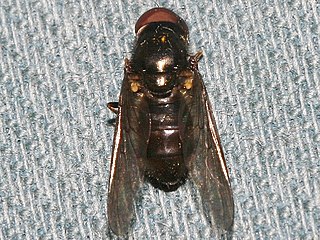
Hover flies, also called flower flies or syrphid flies, make up the insect family Syrphidae. As their common name suggests, they are often seen hovering or nectaring at flowers; the adults of many species feed mainly on nectar and pollen, while the larvae (maggots) eat a wide range of foods. In some species, the larvae are saprotrophs, eating decaying plant and animal matter in the soil or in ponds and streams. In other species, the larvae are insectivores and prey on aphids, thrips, and other plant-sucking insects.

Eristalinae are one of the four subfamilies of the fly family Syrphidae, or hoverflies. A well-known species included in this subfamily is the dronefly, Eristalis tenax.

Sericomyia transversa , the Yellow-spotted Pond Fly , is an uncommon species of syrphid fly observed in northeastern North America.. Hoverflies can remain nearly motionless in flight. The adults are also known as flower flies for they are commonly found on flowers, from which they get both energy-giving nectar and protein-rich pollen. The larvae of this genus are known as rat tailed maggots for the long posterior breathing tube.
Spilomyia crandalli, Crandall's Hornet Fly, is a rare species of syrphid fly first officially described by Curran in 1951. This species is found in western North America near the Pacific coast. Hoverflies get their names from the ability to remain nearly motionless while in flight. The adults are also known as flower flies for they are commonly found around and on flowers, from which they get both energy-giving nectar and protein-rich pollen. The larvae are known as the short-tailed larvae, suited for moist areas such as rot holes of trees.

Spilomyia liturata, the Rocky Mountain Hornet Fly, is an uncommon species of syrphid fly. This species is found in western North America along the Rocky Mountains. Hoverflies get their names from the ability to remain nearly motionless while in flight. The adults are also known as flower flies for they are commonly found around and on flowers, from which they get both energy-giving nectar and protein-rich pollen. The larvae are known as the short-tailed larvae, suited for moist areas such as rot holes of trees.

Anasimyia bilinearis, the two-lined swamp fly, is an uncommon species of syrphid fly observed throughout North America. Hoverflies can remain nearly motionless in flight. The adults are also known as flower flies for they are commonly found on flowers from which they get both energy-giving nectar and protein-rich pollen. Larvae of this genus are of the rat-tailed type living in aquatic environments.

Anasimyia chrysostoma, the lump-legged swamp fly , is a fairly common species of syrphid fly observed across the United States and Canada. Hoverflies can remain nearly motionless in flight. The adults are also known as flower flies for they are commonly found on flowers from which they get both energy-giving nectar and protein-rich pollen. Larvae of this genus are of the rat-tailed type living in aquatic environments.

Anasimyia distincta, the short-spurred swamp fly, is a rare species of syrphid fly observed in The Northeastern United States and adjacent Canada. Hoverflies can remain nearly motionless in flight. The adults are also known as flower flies for they are commonly found on flowers from which they get both energy-giving nectar and protein rich pollen. Larvae of this genus are of the rat-tailed type living in aquatic environments.

Parhelophilus integer , the shiny bog fly, is a rare species of syrphid fly observed in the Eastern United States. Hoverflies can remain nearly motionless in flight. The adults are also known as flower flies, for they are commonly found on flowers from which they get both energy-giving nectar and protein-rich pollen. The larvae of this genus are the long tailed "rat-tailed" type.
Parhelophilus porcus , the black bog fly, is an uncommon species of syrphid fly observed in Northern North America. Hoverflies can remain nearly motionless in flight. The adults are also known as flower flies for they are commonly found on flowers from which they get both energy-giving nectar and protein-rich pollen. The larvae are the long tailed "rat-tailed" type.
Parhelophilus divisus the yellow-legged bog fly, is a rare species of syrphid fly observed in the northeastern United States. Hoverflies can remain nearly motionless in flight. The adults are also known as flower flies for they are commonly found on flowers, from which they get both energy-giving nectar and protein rich pollen. The larvae are the long tailed "rat-tailed" type.
Platycheirus inversus, also known as the knobfoot sedgesitter, is a rare species of syrphid fly observed in Northeastern North America. Hoverflies can remain nearly motionless in flight. The adults are also known as flower flies for they are commonly found on flowers, from which they get both energy-giving nectar and protein-rich pollen. Larvae are aphid predators.
Platycheirus modestus , also known as the yellow sedgesitter, is an uncommon species of syrphid fly observed throughout Northern North Amnerica. Hoverflies can remain nearly motionless in flight. The adults are also known as flower flies for they are usually found on flowers from which they get both energy-giving nectar and protein-rich pollen. Larvae are aphid predators.
Platycheirus nearcticus, the Nearctic broadhand sedgesitter, is a common species of syrphid fly observed in mainly in northeastern North America but scattered more broadly across the continent. Hoverflies can remain nearly motionless in flight. The adults are also known as flower flies for they are commonly found on flowers from which they get both energy-giving nectar and protein rich pollen. Larvae are aphid predators.

Platycheirus pictipes, the cobalt sedgesitter, is a common species of syrphid fly observed in Western North America and across Canada. Hoverflies can remain nearly motionless in flight. The adults are also known as flower flies for they are commonly found on flowers from which they get both energy-giving nectar and protein-rich pollen. Larvae are aphid predators.
Platycheirus thompsoni, or Thompson's sedgesitter, is an uncommon species of syrphid fly observed in northeastern North America. Hoverflies can remain nearly motionless in flight. The adults are also known as flower flies, for they are commonly found on flowers, from which they get both energy-giving nectar and protein-rich pollen. Larvae are aphid predators.

Cheilosia latrans, the steely blacklet, is a very common species of syrphid fly observed in northern North America hoverflies can remain nearly motionless in flight. The adults are also known as flower flies for they are commonly found on flowers from which they get both energy-giving nectar and protein rich pollen. Larvae when known are plant feeders.
Cheilosia caltha, the prairie blacklet, is a fairly common species of syrphid fly observed across North America. Hoverflies can remain nearly motionless in flight. The adults are also known as flower flies for they are commonly found on flowers from which they get both energy-giving nectar and protein rich pollen. Larvae, when known, are plant feeders.
Heringia rita, the black-faced spikeleg, is a common species of syrphid fly observed in many locations across North America. Hoverflies can remain nearly motionless in flight. The adults are also known as flower flies for they are commonly found on flowers, from which they get both energy-giving nectar and protein-rich pollen. Larvae have been reared from Adelges piceae and Eriosoma lanigerium.
Trichopsomyia banksi ,the white-faced psyllid killer, is an uncommon species of syrphid fly observed across North America. Hoverflies can remain nearly motionless in flight. The adults are also known as flower flies for they are commonly found on flowers from which they get both energy-giving nectar and protein-rich pollen. Larvae are unknown but other members of this genus are psyllid, aphid and Phylloxera predators.










